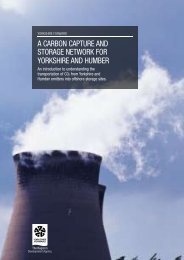Final report for One North East And NEPIC 21/12/10 - The Carbon ...
Final report for One North East And NEPIC 21/12/10 - The Carbon ...
Final report for One North East And NEPIC 21/12/10 - The Carbon ...
You also want an ePaper? Increase the reach of your titles
YUMPU automatically turns print PDFs into web optimized ePapers that Google loves.
<strong>The</strong> case <strong>for</strong> a Tees CCS network<strong>Final</strong> Report7. Government support will be critical to attracting private capital 88 . Given theconcerns of private lenders in relation to the commercial risk profile of a CCS networkprojects, it is likely that some of the project challenges can only be accepted and/oraddressed by the public sector. In addition to the demonstration funding required tooffset some of the incremental capital costs of CCS, Government can potentiallyprovide support through the creation of stable revenues streams (carbon floor prices 89 ,revenue guarantees, decarbonised obligations, energy per<strong>for</strong>mance standards),providing additional support throughout the project cycle (Regional Growth Fund 90 ,CCS Levy, per<strong>for</strong>mance-based funding) and providing soft loans, structured financeand project underwriting/guarantees to cover technology risk (e.g. via the GreenInvestment Bank). <strong>The</strong>re may be an option to use the free allowances <strong>for</strong> industry andcash compensation <strong>for</strong> indirect emissions to finance the development of CCS. Publicsupport will be required to de-risk those aspects that are unmanageable and there<strong>for</strong>edeemed too risky by commercial lenders; use of public funds to support projects willprovide the confidence in the emergence of effective policies and regulations uponwhich the commercial success of the project is contingent, potentially providing a routeto leverage private capital into CCS demonstration. Once the concerns of lenders arereduced, the role of government can be lessened.<strong>Final</strong>ly, the revenue streams provided by enhanced oil recovery (EOR) could significantlychange the economics of the CCS network and there<strong>for</strong>e the availability of privateinvestment. EOR can provide a revenue stream that could enhance overall projecteconomics. Once a significant and predictable volume of CO 2 is captured from Teessideand the offshore storage is proven, the potential <strong>for</strong> diverting CO 2 <strong>for</strong> tertiary oil productionusing EOR may serve to attract additional sources of private finance. However, given thelimited window of opportunity and high complexity <strong>for</strong> EOR, unless EOR activities can beguaranteed up front, it should only be viewed as the „icing on the cake‟ providing additionalpotential upside <strong>for</strong> network sponsors.<strong>The</strong>re is considerable activity to develop financing mechanisms to support large scale lowcarbon infrastructure beyond the above established mechanisms, so that it will benecessary to review the conclusions contained within this chapter on an on-going basis.Financing <strong>for</strong> higher risk projects typically comes from public grants, equityinvestment, and guarantees. Capital providers will dictate required returns on thebasis of quantitative examination of scenarios. Up-front public grant support to ananchor project is required. Debt finance (e.g. through syndicated loans) is likely to belimited, although over time once risks have been reduced there would be a number ofoptions <strong>for</strong> refinancing with lower cost of capital. Strategic equity investment will berequired from a coalition of willing sponsors – who will need good track records.Government can leverage private finance through removing risks. Unless EORcommitments are made up-front, they should only be viewed as providing upsidepotential.88 Just prior to this <strong>report</strong> being published, the Government issued a Call <strong>for</strong> evidence on long term developmentof CCS infrastructure, available athttp://www.decc.gov.uk/en/content/cms/consultations/ccs_3rd_party/ccs_3rd_party.aspx89 Interestingly the wide range of prices <strong>for</strong> individual businesses highlights the challenge to Government insetting a single carbon floor price, i.e. any given price more than required <strong>for</strong> some emitters (dead weight losses)and insufficient <strong>for</strong> others.90 http://www.bis.gov.uk/policies/regional-economic-development/regional-growth-fund54







